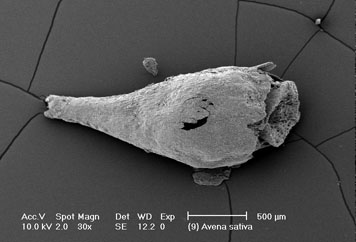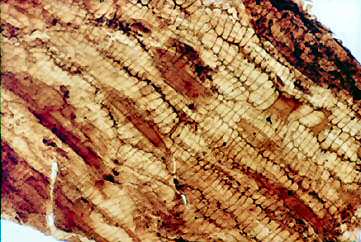

What are plant macrofossils and how are they analysed?Botanical macrofossils are the remains of large plant parts – seeds, leaves, stems etc. – preserved either in natural or cultural deposits. When these plant remains are from an archaeological context, their study is called archaeobotany.
 |
 |
| Electron micrograph of a carbonised flower base of Avena (oat) | Micrograph of a testa fragment of Secale cereale (rye) |
Botanical macrofossils are found in almost all archaeological layers, but in varying numbers and conditions depending on the prevailing circumstances. In dry mineral soils, where most archaeological finds are made, it is mainly charred plant remains that are found. In waterlogged, oxygen-poor layers, for example in urban strata, bogs and lakes, large amounts of uncharred plant remains are also encountered. Other forms of preservation, mineralised and desiccated remains, impressions on potsherds, daub etc., are rarer occurrences.In many cases, and especially in analyses of the above-mentioned waterlogged deposits, the composition and structure of the strata are as important for the overall interpretation as the macrofossil content. Accordingly, a record of the stratifigraphy and descriptions of the sediments form a crucial part of the analysis. Deposits are primarily examined and described in the field in connection with sample collection. Close attention is paid to the type, stratigraphy and original orientation of the deposits so that the descriptions can be supplemented by more detailed observations in the laboratory.
Plant macro-fossilanalyses requires examination under a stereo microscope at magnifications of x6-x100. Some finds, for example pure concentrations of charred grain, can be analysed without preliminary treatment. In other cases the content of plant remains must be concentrated before it can be analysed. Soil samples with a high content of mineral material relative to charred plant remains are subjected to flotation, ideally in the field. This process utilises water and differences in specific gravity to separate charred plant remains from stones, gravel, sand etc. Flotation is never used on uncharred material or specimens that only contain a little mineral material. Such material is sent untreated to the lab, where it is carefully washed through an array of fine-meshed sieves (down to a minimum of 0.25mm) before being examined.